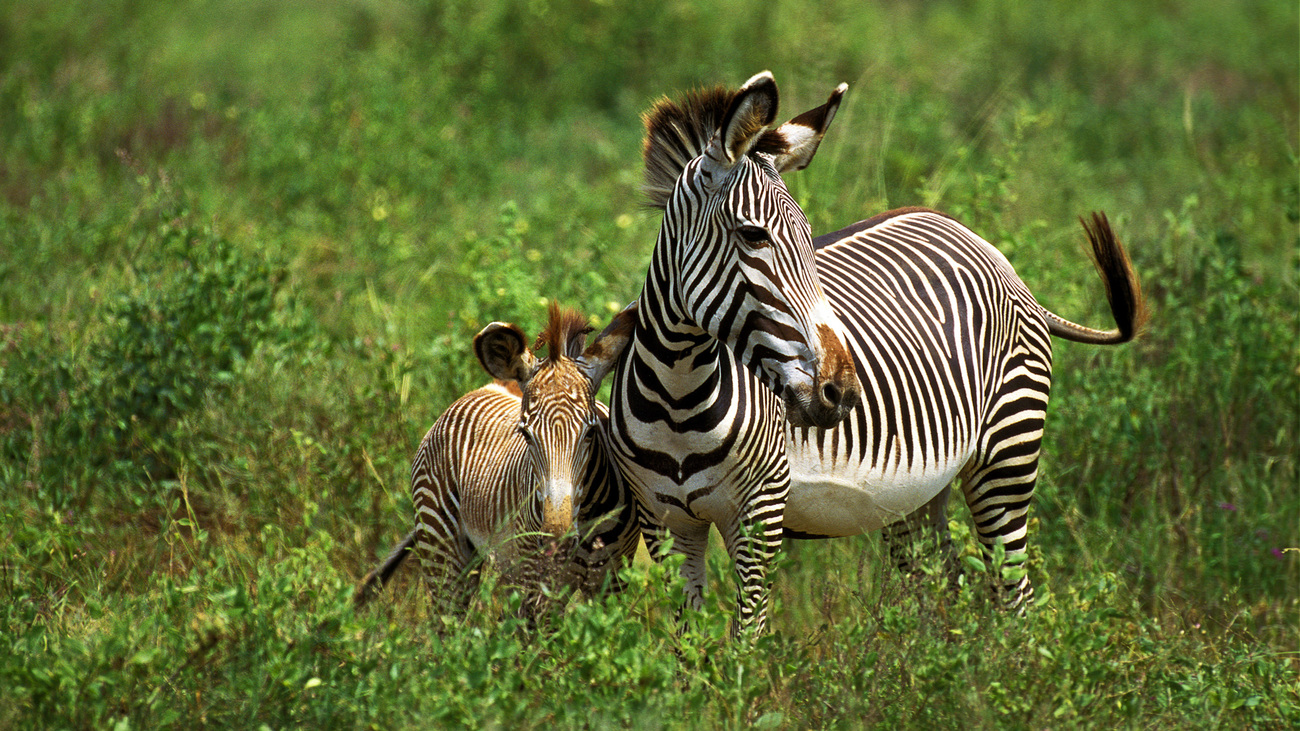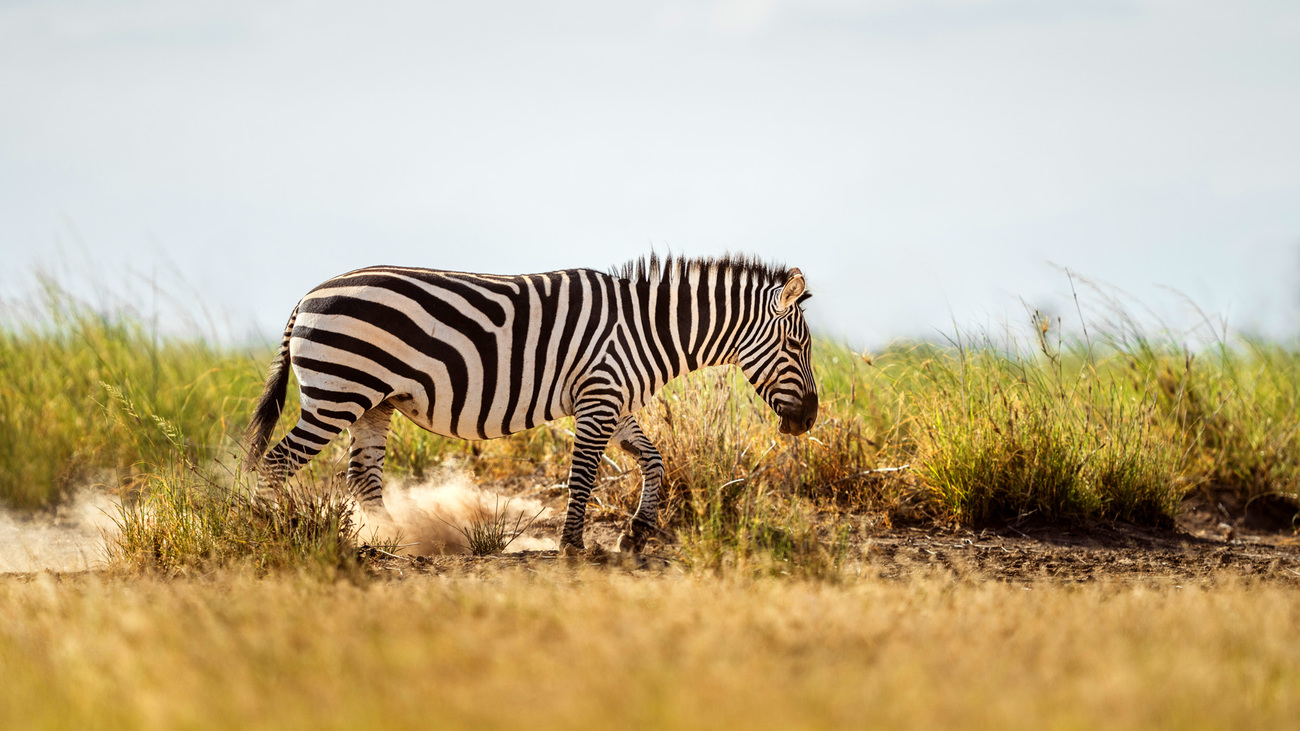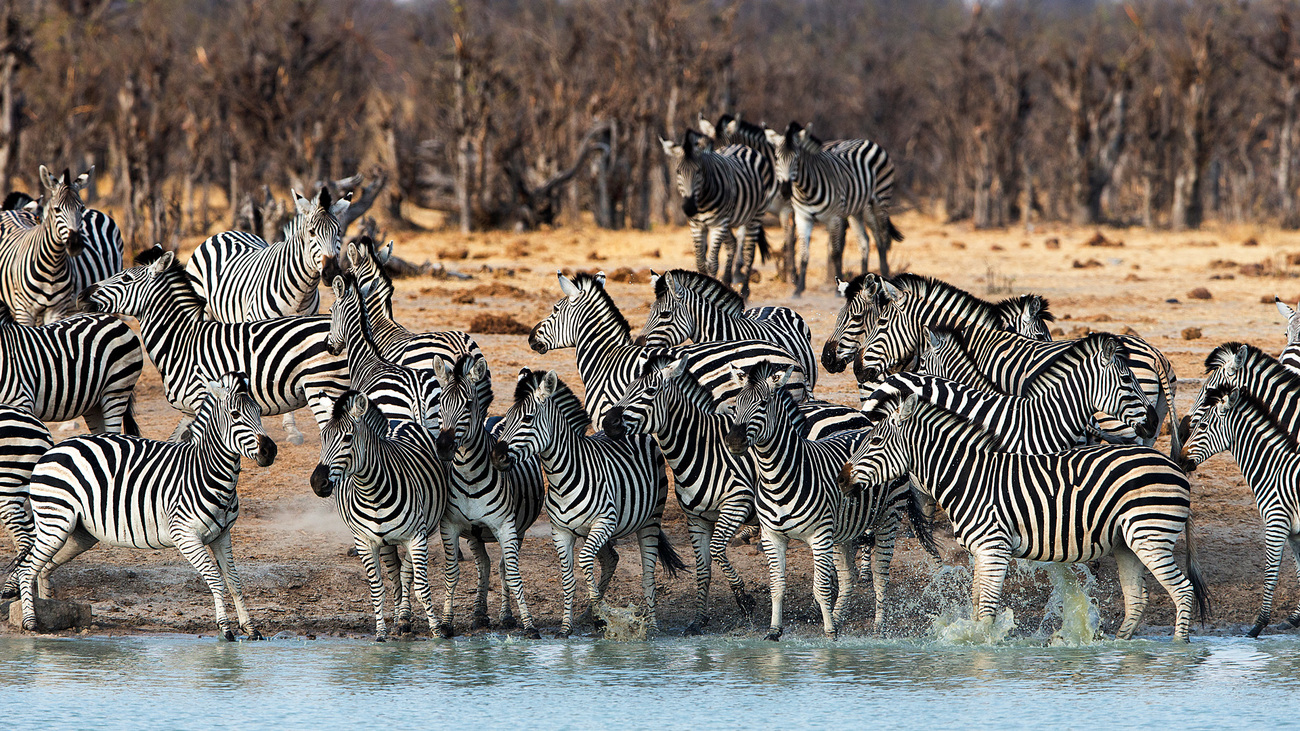Zebras
What is a zebra?
Zebras are African mammals known for their distinctive black and white stripes, which help deter biting horseflies. Despite much debate surrounding which is their ‘base’ color, zebras are considered to be black with white stripes in their fur.
As part of the horse family, they have an equine-like appearance with long legs and a mane along their neck. Each zebra’s stripes are unique, much like human fingerprints.
Zebras are primarily found in various African habitats, ranging from savannahs and grasslands to mountainous regions. A zebra’s species determines their preferred habitat, with different types occupying different geographical areas.
There are three species of zebra—the plains zebra, Grevy’s zebra, and the mountain zebra. You can tell the different species apart by their different stripe patterns.
Plains zebras are the most common. They have wide stripes that are set far apart. They’re found in the grasslands across much of eastern and southern Africa.
Identifiable by their narrower stripes, Grevy’s zebra is the most threatened species. These zebras live in dry, sparsely wooded areas in Kenya and southern Ethiopia.
The mountain zebra lives in dry upland plains in southern Africa, particularly in Namibia.
Male Grevy’s zebras are larger than females. Both males and females are nearly the same size for the plains zebra and the mountain zebra.
Of all the species, the Grevy’s zebra is the largest, measuring 1.24 to 1.6 meters (4.1 to 5.3 feet) tall at the shoulder. They typically weigh 350 to 250 kilograms (750 to 1000 pounds).
The mountain zebra is a little shorter and lighter to help it navigate rugged terrain. It is 1.16 to 1.45 meters (3.8 to 4.8 feet) tall at the shoulder, and it weighs 200 to 430 kilograms (450 to 950 pounds).
Plains zebras are about the same size as their mountain-dwelling counterparts. They have an average height of 1.1 to 1.5 meters (3.6 to 4.8 feet) at the shoulder, weighing 175 to 400 kilograms (380 to 850 pounds).
Zebras are mammals, meaning they reproduce through giving birth to live young and nurse them with milk. After a gestation period of around 11 to 13 months, a female zebra gives birth to a single foal, which can stand and walk shortly after birth. The mother is generally the one who raises the young, though she receives additional protection and support from the herd.
Zebras play a crucial role in maintaining the balance of ecosystems. They are considered ‘pioneer grazers’, and their grazing helps prevent the overgrowth of certain plant species, which leads to more biodiversity.
As herbivores, zebras eat only plants—mostly leaves, shrubbery, and small trees. They are a keystone species, meaning they are vital for the survival of their habitat. By eating taller, sturdier plants, zebras prepare the landscape for smaller animals who rely on shorter, more nutrient-dense grasses.
Additionally, zebras are an important prey species, supporting the carnivores in their ecosystems. They face threats from predators such as lions, hyenas, and crocodiles. Their speed and agility are crucial defense mechanisms, and they often travel and live in large packs for protection.
What is a zebra’s scientific name?
Each species of zebra has a different scientific name:
- Grevy’s zebra: Equus grevyi
- Mountain zebra: Equus zebra
- Plains zebra: Equus quagga
Grevy’s zebra is named after Jules Grevy, a former president of France. President Grevy was given a zebra as a gift in 1882 by the king of Abyssinia (now Ethiopia). Zoologists realized this zebra was different from other species they had seen and named it after the president.
Are zebras endangered?
The three species of zebra have varied threat levels. According to the IUCN:
- Mountain zebras are vulnerable
- Plains zebras are near threatened (though they’re considered close to vulnerable)
- Grevy’s zebras are endangered
Where do zebras live?
The three species of zebra live in different areas across the African continent.
Grevy’s zebras live in arid shrubland and grassland in Kenya and some remote parts of southern Ethiopia.
Plains zebras are the species of zebra with the largest range and are found from South Sudan and southern Ethiopia as far east as the Nile River, and as far south as southern Angola and northern Namibia and northern South Africa. They thrive in savannahs, shrublands, and grasslands.
Mountain zebras, as the name suggests, live at a higher altitude. Found in South Africa, Namibia, and Angola, they can survive in more rugged, mountainous terrain and escarpment areas up to 2000 meters above sea level.
Threats
Zebras face several threats that have made their populations vulnerable, including hunting, habitat loss, disease, and climate change.

Climate change
Zebras are particularly vulnerable to droughts. As droughts spread throughout Africa and occur more frequently, they lead to reduced water sources and restrict zebras’ access to water and food.
In 2022, a devastating drought in Kenya threatened the survival of Grevy’s zebras, an already endangered species. After experiencing four rainy seasons without rain, northern Kenya’s wild animals are living through a catastrophic climatic event.
Hunting
Zebras are hunted for their iconic black and white skins. Some subspecies of zebra have already been driven to extinction by hunters. The quagga is a plains zebra subspecies that was over-hunted to extinction in the late 1800s.
In some areas, zebras are also hunted for their meat by local tribes, either for sustenance or for sale. This is particularly a threat for plains zebras, especially when they move out of protected areas.
Sadly, zebras are captured and sold into the exotic pet trade as well. Across the world, including in the US, zebras are prized for their rarity and kept in peoples’ homes like pet horses. In fact, in 2021, three pet zebras escaped from the property of an exotic animal breeder in the US, highlighting yet again the issues with trying to keep wild animals in captivity.
Habitat loss
Zebras are facing an ongoing struggle of habitat loss, driven primarily by three causes:
- Agriculture and aquaculture
- Livestock farming and ranching
- Residential and commercial development
Livestock farming, ranching, and agriculture often come with fences that block plains zebras’ migration corridors, preventing them from completing their annual migrations each season. This, in turn, can lead to reduced food sources and fragmentation of zebra populations.
In particular, Grevy’s zebras used to be found all over Africa. Fossils indicate that their range once stretched across Asia all the way to China. Now, the subspecies is only found in Kenya and Ethiopia, with fewer than 3,000 individuals left in the wild.
As more habitat is taken up by farming, agriculture, and urban development, zebras are left with insufficient space to live in. They have to compete for food and water sources with other animals and fellow zebras, traveling long distances to find resources.
Disease
While all zebras suffer from a number of diseases—including outbreaks of anthrax, Theileria and Babesia (tick-borne diseases), and West Nile Virus—Grevy’s zebras are hit the hardest.
When zebras come into contact with unvaccinated livestock, they can easily pick up diseases. As they face habitat loss, zebras are forced into closer quarters with other animals, including livestock, leading to more dangerous infections. These diseases could decimate entire populations of the already endangered Grevy’s zebra.
Loss of genetic diversity
Genetic diversity loss is a major issue for a mountain zebra subspecies called the Cape mountain zebra. They have a very small population, which means the risk of inbreeding is high.
Inbreeding leads to a lack of genetic diversity, making zebras susceptible to disease and illness. As more habitat is lost and the zebra populations become fragmented, genetic diversity becomes harder to come by.
FAQs
What does a zebra eat?
Zebras are herbivores and primarily graze on grasses. Their diet consists mainly of various types of grass, though they may also eat leaves, buds, bark, shrubs, and small trees.
As a keystone species, their eating patterns help conserve the health of the whole ecosystem. Their munching helps to prepare plains for other grazing animals that require shorter, more nutritional grasses.
Of course, water is crucial for zebras, and they often need to drink regularly to stay hydrated, especially in their natural habitats, like African savannahs.
Are zebras black or white?
Zebras are black with white stripes. Their white strips result from a lack of melanin, which causes their hair to have zero pigment in those areas.
If you shaved a zebra, the skin underneath their fur would be all black.

Are zebras faster than horses?
Though the two animals share characteristics, zebras are not faster than horses.
Zebras have an average top speed of 64 kilometers per hour (40 miles per hour) while horses can reach speeds of 88 kilometers per hour (55 miles per hour).
Do zebras sleep standing up?
Just like horses, zebras can sleep while standing upright. While standing, they can enter a light sleep state where they are still aware of their surroundings, which allows them to quickly respond to potential threats and predators.
However, zebras also lie down for periods of deeper sleep, particularly at night, when they feel safer.
What is the lifespan of a zebra?
On average, a zebra will live up to 25 years in the wild.
What are the three types of zebras?
There are three main species of zebras.
The plains zebra is the most widespread species. Plains zebras are known for their distinctive wide black and white stripes, and they inhabit various grasslands and savannahs in eastern and southern Africa.
Grevy’s zebras are the largest of the three species and have narrower stripes than the plains zebra. They are native to the arid regions of East Africa, particularly Ethiopia, Kenya, and Somalia.
Mountain zebras have two subspecies—the Cape mountain zebra and the Hartmann’s mountain zebra. They are smaller than the plains zebra and have a unique stripe pattern, with a grid-like pattern on their rump. They are found in South Africa, Namibia, and Angola.
Each species has its own distinct characteristics, including variations in stripe patterns, size, and habitat.

How close are zebras to extinction?
The endangered status of zebras varies by species.
The zebra species with the smallest population left in the wild is Grevy’s zebra, which has around 1,900 mature individuals remaining. They are considered endangered by the IUCN and, for now, are at greater risk for extinction than the other two species.
Some subspecies of zebra, like the quagga, have already gone extinct due to human activity. The last known surviving quagga died in the London Zoo in 1872.
Are zebras friendly?
In general, zebras are known for being social animals within their herds and exhibit a degree of friendliness or tolerance toward each other. Occasionally, males can be aggressive, particularly when defending their territory.
However, when it comes to human interactions, it’s essential to remember that zebras are not domesticated like horses. They are not friendly towards humans and have been known to attack people—perhaps one of the reasons they were never domesticated in the first place.
Zebras are wild animals and should not be kept as pets. Despite this, zebras are highly sought after in the illegal pet trade.
Our work
IFAW helps protect endangered species worldwide, including zebras.
In 2022, drought swept through northern Kenya after four failed rainy seasons in a row, threatening the endangered Grevy’s zebra.
Thankfully, Grevy’s Zebra Trust (GZT), the only organization in the world focused entirely on conserving Grevy’s zebra in Kenya, provides vital care to these vulnerable animals, supported by IFAW.
GZT observed declining forage and water, provided wild zebras with extra food when needed, and ensured they were getting enough water—an essential requirement for nursing mothers.
IFAW also worked on translocating animals, including zebras, to the protected Kasungu National Park in western Malawi in 2015. Decades of severe poaching and encroachment into the park had all but decimated the wild animals that had once lived there. Reintroducing diverse animals and supporting wildlife rangers has returned the park to the thriving ecosystem it is today.
Together with our partners on the ground worldwide, our commitment is to create a future where animals and people can thrive together.

How can you help?
Zebras face several threats to survival, including climate change, hunting, habitat loss, and disease. IFAW is working to help conserve zebra populations and their habitats.
